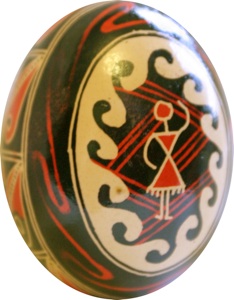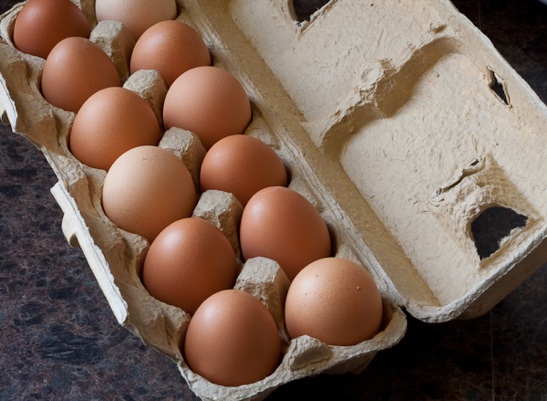Working with
Brown Eggs

Working with
Brown Eggs
Working with Brown Eggs
Working with brown eggs can be very rewarding. It is not difficult, just different, and the result can be quite gorgeous. The brown shell varies a lot from egg to egg, and eggshell colors can range from almost a pure white to a light mocha to a reddish brown, with every gradation in between. Interestingly, in many languages (Ukrainian included), the eggs we refer to as brown are called “red” eggs.

It can sometimes be hard to visualize how your dyes will look on a brown shell – some colors are enhanced, some are fairly similar, and others don’t look particularly good. Only by experimenting a bit can you learn which dyes will work on which shells (see here for examples).
When working with brown eggs, I try to keep the number of colors to a minimum. I usually make “two-tone” eggs, with the natural shell and then a final color (most often black). Occasionally I will add another color to this scheme, often red.
There are several things to keep in mind when working with brown eggs. Based on my experience, I have noticed the following:
1.Dyeing time: Brown eggs seem to have glossier shell, and it may take the dye much longer to adhere properly. I sometimes have to soak the pysanka in black for up to an hour, rather than the usual five to ten minutes (and, on rare occasions, even longer). You will have to test your own eggs to see if this holds true for you.
Giving the brown egg a longer soak in vinegar solution than usual may also be of benefit.

3.Spoilage: Brown eggs seem to “go bad” much more frequently than white ones, and will do so even when refrigerated. More than once I have opened the egg fridge only to smell that unpleasant “bad egg” smell. I’ll go through the cartons of eggs and sniff the eggs individually; for some reason it is almost always the brown ones that go bad.
If the egg is otherwise nice, and the insides fairly liquid, I’ll hold my nose and empty it and use it later. I rinse a lot. If the egg contents are thick and pasty when I try to empty, I will usually just discard it into the compost.
4.Seepage and Leakage Brown eggs are also much more likely to have leakage or seepage through an intact shell than white ones. I can only assume that this is due to some defect in the inner membrane, but don’t know if this is universal, or just something having to do with the brands I use.
What is the difference between leakage and seepage? I’ll sometimes come to my work table, notice an unpleasant odor, and find an egg that is sitting in a puddle of vile-smelling fluid brownish fluid. Other times it will be an egg in a carton in the fridge. This is leakage of the egg contents through the shell. I will usually toss these eggs; even if I were to empty them out, these is a good chance dye could leak bak into the egg and cause problems later.
Other times I will notice brownish crystals on the surface of the egg while I am working on it. This is seepage of small amounts of egg content through the shell. If I notice this on an unused egg, I don’t simply wash the crystals off. The egg will continue to seep, and will ruin any work done on it. The crystals will ruin the dyed surface, and will even form under a coat of varnish. I toss these eggs.
If such seepage occurs while I am working on an egg, I will empty it immediately, rinse well, and allow it to dry out properly. I will then seal the egg with wax and re-dye, finishing the pysanka as planned. (Note: emptying the egg may be a very smelly proposition. Make sure you have some Febreeze on hand.)
I try to avoid these outcomes by not leaving full brown eggs out very long (i.e. keeping refrigerated until shortly before using them, perhaps 24 hours or so). If I keep them refrigerated at a constant temperature, the inside will usually dry out normally. My egg fridge is old, and sometimes gets warmer than it should if I do not defrost regularly.
Also, DO NOT SHAKE brown eggs. I used to do this to see if the insides were still fluid enough to empty,and found that just a bit of shaking can be enough to tear the egg membranes and cause them to seep or leak.
5.Strength: The shells of brown eggs are thicker and stronger than those of white eggs. When etching, you can go a lot deeper on a brown egg than on a white one. I also find that I can use extra-large and jumbo brown eggs for writing pysanky, something I do not normally do with white eggs because of the weakness of the shells on the larger sizes. Organic or Amish extra larges can be fine in the white eggs, but jumbos are usually much too weak, unlike brown eggs, where all the sizes appear to have a strong, thick shell.
6.Surface: Brown eggs are often more nicely shaped, and have fewer surface irregularities. I don’t know why this is, but I can use most of the eggs in a dozen large brown eggs for pysanky, but only about 50% to 70% of those in a dozen large white eggs. Using brown eggs mean less “wastage.”
You can find examples of my brown egg pysanky on the following pages.


